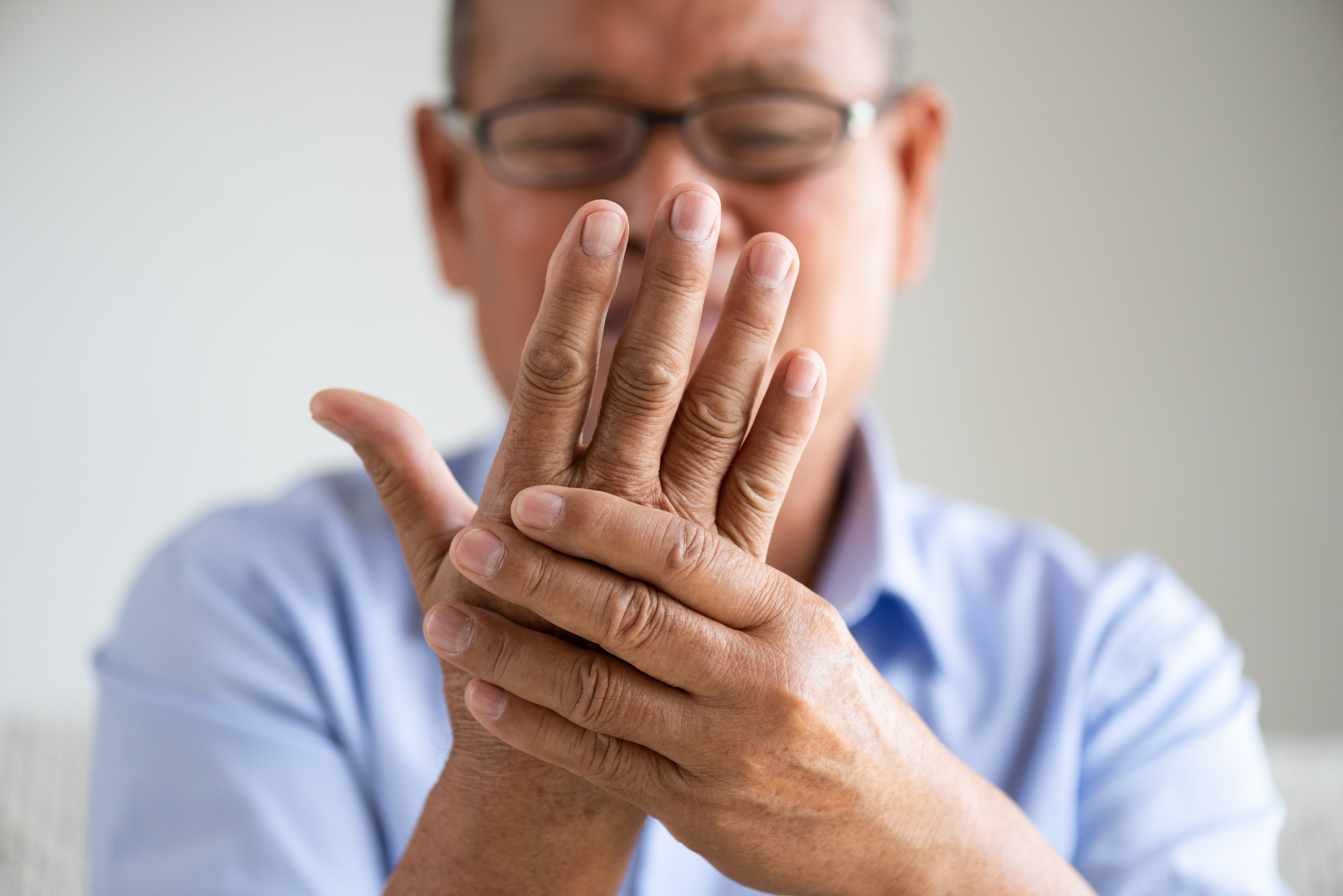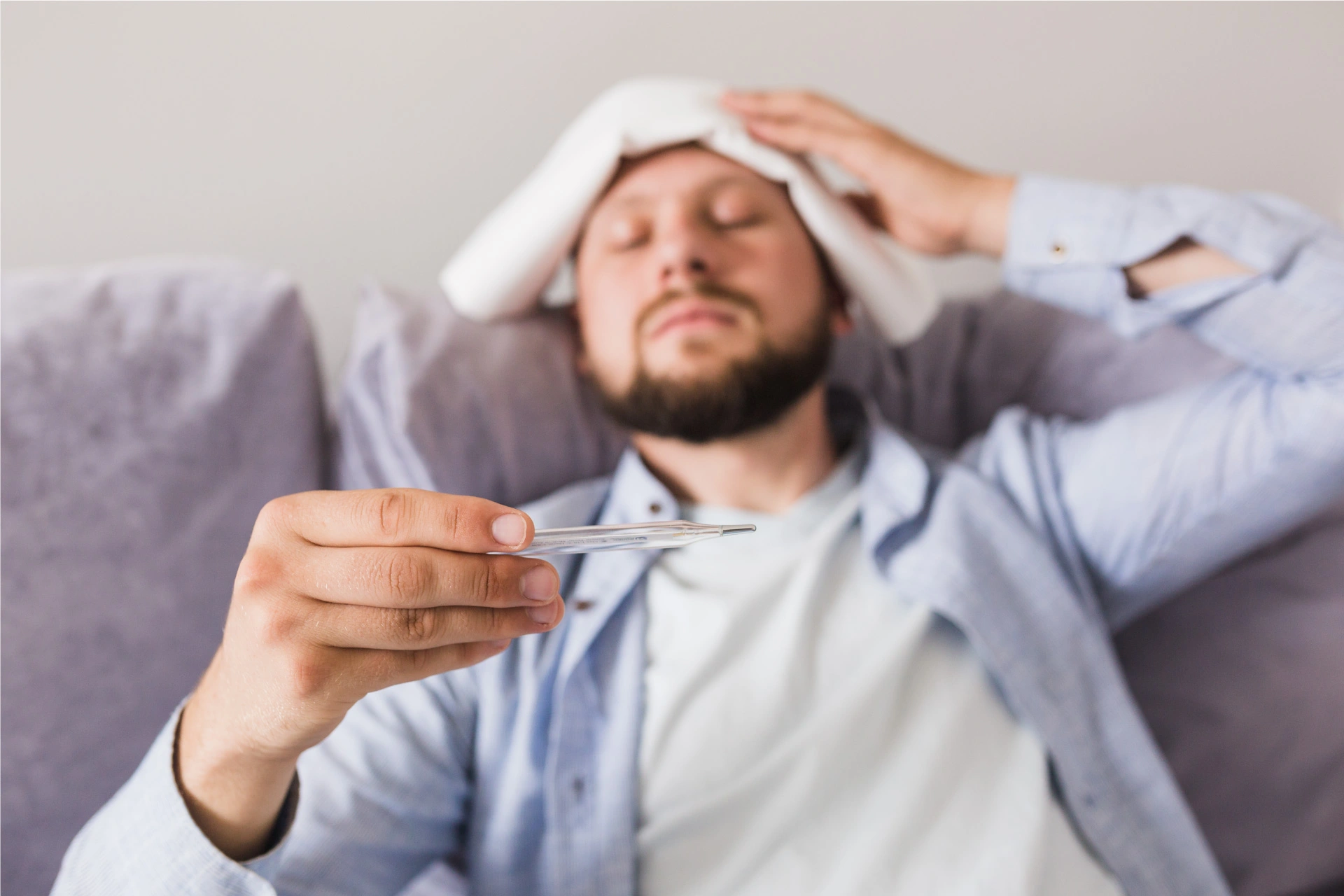Allergy & Immunology | 12 min read
Parkinson’s Disease: Symptoms, Causes, Treatments
Medically reviewed by
Table of Content
Key Takeaways
- Parkinson’s disease is a degenerative disorder of the central nervous system that impairs a person’s motor skills
- The disease is characterized by tremors, rigidity, slow movement, and difficulty with balance
- While there is no cure for Parkinson’s, treatments available can help improve symptoms and quality of life
Parkinson’s disease is a neurodegenerative brain disorder that is characterised by motor symptoms such as tremors, rigidity, imbalance, and slowed movement, and non-motor symptoms like loss of smell and sleep problems. In India, Parkinson’s disease affects over 1 million persons a year. The disease gets worse over time and affects the dopamine-producing nerve cells in the brain. The body shows signs of Parkinson’s like tremor in one hand, rigidity, or slowness of movement when the dopamine levels drop by ~60-80%,
Parkinson’s symptoms intensify over time and sadly, there is no cure for the disease at present. Nevertheless, there are medical means of managing and improving symptoms. Parkinson’s disease tends to show up more in men and affects those who are of 60 years of age and above. If you have basic knowledge of Parkinson's, it might help you tend to the affected person.
What is Parkinson’s disease?
Parkinson’s disease is a long-term neurodegenerative disorder that affects a section of the brain called the substantia nigra. The substantia nigra produces the hormone dopamine, which coordinates motor movements. Since these dopamine-producing neurons are affected by Parkinson’s disease, motor-system symptoms like shaking, imbalance while walking, and stiffness are common with patients.
How Does Parkinson's Disease Affect the Body?
It often starts in people 60 years old or older. It is more common in men than women and slightly more common in Designated Male At Birth (DMAB) than in Designated Female At Birth (DFAB). Parkinson's disease is rare, and most people experience symptoms after 65 years of age. However, it can happen earlier in individuals with a family history of Parkinson's.
Parkinson's Disease Causes
Reduced Dopamine Level
Dopamine is a neurotransmitter that is important to movement and coordination. In Parkinson’s patients the neurons that produce dopamine become impaired or die. The motor symptoms aggravate when the dopamine levels continue to fall.
Low Norepinephrine Levels
Parkinson’s patients tend to exhibit reduced amounts of norepinephrine, a neurotransmitter that is important to automatic body functions such as heart rate and blood pressure. Here, the nerve endings that produce this chemical die.
Presence of Lewy Bodies
Brain cells of Parkinson’s patients have been found to contain abnormal clumps of a protein called Lewy bodies. Scientists are researching the link between the protein alpha-synuclein, a substance found in Lewy bodies, and Parkinson’s disease.
Genetic and Environmental Factors
Scientists are exploring whether certain genetic factors or mutations may lead to Parkinson’s. Sometimes the disease may appear to be hereditary, but research points in the direction of genetic factors along with environmental triggers, such as exposure to toxins and pollutants.
Parkinson's Disease Early symptoms
Early symptoms of Parkinson's disease can be subtle and difficult to spot. They can include:
- Tremor, or trembling, in your hands, arms, legs, jaw, or face
- Stiffness in your limbs and trunk
- Slow movement
- Impaired balance and coordination
If you or someone you know is experiencing these symptoms, it's important to see a doctor for a proper diagnosis. Parkinson's disease is a progressive condition, so early diagnosis and treatment are crucial. Unfortunately, there is no one-size-fits-all approach to managing Parkinson's, but treatments can help relieve symptoms and improve quality of life.
Parkinson's Disease Symptoms
Four main symptoms of Parkinson’s disease as mentioned above are:
- A tremor in hands, legs, arms, jaw, or head
- Rigid muscles or stiffness of the arms, legs, and trunk
- Slowed movement (bradykinesia), for instance, dragging feet
- Impaired balance, which can lead to falls
Other symptoms, including those which are not linked to the movement (non-motor), include:
- Loss of smell
- Change is posture and gait, sometimes as if leaning forward
- Depression
- Anxiety
- Changes in emotion
- Difficulty in swallowing or chewing
- A tremor in voice or softer voice
- Cramped handwriting
- Sleep problems
- Skin problems
- Constipation or urinary problems
- Reduced automatic movements like smiling or swinging arms when walking
Secondary Symptoms
Many people with Parkinson's disease (PD) experience secondary symptoms that can be just as debilitating as primary motor symptoms. These secondary symptoms can include problems with sleep, mood, memory, and more.
- One of the most common secondary symptoms of PD is sleep problems. People with PD may have difficulty falling asleep or staying asleep. They may also experience vivid dreams or nightmares. In addition, many people with PD find that their sleep is disturbed by their primary motor symptoms, such as racing thoughts, muscle spasms, or restless legs syndrome.
- Mood changes are another common secondary symptom of PD. People with PD may experience depression, anxiety, or irritability. They may also have changes in their personality or become more withdrawn. Mood changes can be caused by the primary symptoms of PD, the medications used to treat PD or the stress of living with a chronic illness.
- Memory problems are also common in PD. People with PD may have difficulty remembering things or concentrating. They may also have executive function problems, including planning, organization, and decision-making. Memory problems can be caused by the primary symptoms of PD, the medications used to treat PD or the stress of living with a chronic illness.
- There are many other secondary symptoms of PD, such as fatigue, pain, gastrointestinal problems, and sexual dysfunction. These symptoms can be caused by the primary symptoms of PD, the medications used to treat PD or the stress of living with a chronic illness.
- If you are experiencing any secondary symptoms of PD, talk to your doctor. There are many treatments available that can help improve your quality of life.
- Even though Parkinson’s disease is linked to motor problems, non-motor issues such as a reduced sense of smell may precede motor symptoms by several years. Other early signs include voice and handwriting changes, a stooped posture, and constipation.
Parkinson’s Dementia
Although Parkinson’s disease is most commonly associated with tremors and motor issues, many people don’t realize that it can also lead to dementia. In fact, according to recent estimates, as many as one million people worldwide suffer from Parkinson’s dementia.
This form of dementia is caused by the same underlying degenerative process that leads to Parkinson’s disease. As nerve cells in the brain break down, they can no longer relay messages properly. This leads to problems with cognition, behavior, and emotion.
Symptoms of Parkinson’s dementia can include memory loss, confusion, and changes in mood and personality. In some cases, these symptoms may be the first sign of Parkinson’s disease, even before motor issues develop.
Parkinson’s dementia can be a devastating condition, but treatments available can help manage the symptoms. If you or a loved one is showing signs of dementia, it’s important to see a doctor for a proper diagnosis. With the right care, people with Parkinson’s dementia can live full and enjoyable lives.
Parkinson’s Disease Stages
It does not affect everyone in the same way. The rate of progression of the disease differs, and the symptoms and their order and intensity may differ too. Nevertheless, below is a generalised 5-stage progression you can acquaint yourself with.
Stage 1
Mild symptoms such as changes in posture, facial expression, and walking, and tremors, and other motor symptoms in one side of the body occur. These usually do not interfere with everyday living.
Stage 2
Stiffness and tremors may intensify and now affect both sides of the body, albeit one less than the other. Symptoms like poor posture and impaired walking become more apparent. The time it takes to complete tasks increases, but the person is independent.
Stage 3
This is the mid-stage and is characterised by a loss of balance, slower movements, and decreased reflexes. Hence, persons in this stage are prone to falls. The person is still independent, but the disease significantly affects the ability to perform daily tasks such as eating and dressing.
Stage 4
At this stage, persons display the need for a walker for movement, though they can stand on their own. The motor symptoms impair movement and reaction times, making it difficult for the patient to live alone and perform daily tasks without assistance.
Stage 5
If Parkinson’s disease progresses to this stage, the person may become bedridden. At any rate, though, the rigidity in the limbs severely affects the ability to stand or walk. Mental symptoms like hallucinations, confusion and delusion may also occur. The person needs 24/7 assistance.
Treatments for Parkinson’s Disease
To date there is no cure to Parkinson’s disease, meaning that treatment efforts are mainly aimed at controlling, relieving, and improving the symptoms.
Lifestyle changes like resting, exercising, and a new diet can help. Doctors may also suggest:
- Speech therapy
- Occupational therapy
- Physical therapy
In terms of medication, commonly-prescribed drugs are:
Levodopa
Levodopa is a medication that is used to treat Parkinson’s disease. It works by increasing the levels of dopamine in the brain. Dopamine is a neurotransmitter that is involved in movement and coordination. Levodopa is usually taken three or four times a day. The medication can be taken with or without food.
Carbidopa
Carbidopa is a medication that is used in the treatment of Parkinson’s disease. It is a dopamine agonist, which means that it helps to increase the levels of dopamine in the brain. Dopamine is a chemical messenger that is responsible for transmitting signals between nerve cells. Carbidopa is typically used with other medications, such as levodopa, to treat the symptoms of Parkinson’s disease. It is usually taken three or four times per day.
Dopamine Agonists like Bromocriptine
Bromocriptine is a medication that is sometimes used to treat Parkinson’s disease. Parkinson’s disease is a condition that affects the nervous system and can cause symptoms such as tremors, stiffness, and problems with balance and coordination. Bromocriptine can help to reduce these symptoms by affecting the levels of certain chemicals in the brain.
Anticholinergics like Benztropine
Benztropine is a medication that is used to treat the symptoms of Parkinson’s disease. It works by reducing the amount of dopamine in the brain. Dopamine is a chemical that is responsible for the control of movement. Benztropine is typically used in combination with other Parkinson’s disease medications.
Amantadine
Amantadine is thought to work by increasing levels of dopamine in the brain. Dopamine is a neurotransmitter that is involved in the control of movement. In Parkinson’s disease, there is a loss of dopamine-producing cells in the brain. This loss of dopamine leads to the symptoms of Parkinson’s disease.
COMT Inhibitors
COMT inhibitors are typically used with other Parkinson’s disease medications, such as levodopa. They may be used to treat early-stage Parkinson’s disease or to help control symptoms in later stages of the disease. COMT inhibitors can be effective at managing symptoms of Parkinson’s disease, but they are not a cure for the disease.
MAO B Inhibitors
There are several MAO B inhibitors available, and they can be used alone or in combination with other Parkinson’s medications. MAO B inhibitors can be an effective treatment for Parkinson’s disease and may help improve symptoms and slow the progression of the disease.
These medications must be taken under observation of a doctor, and in case they do not yield results, the patient may need to undergo Parkinson’s disease surgery, namely:
Deep Brain Stimulation (DBS) Surgery
Deep brain stimulation (DBS) surgery is a treatment for Parkinson’s disease. It involves implanting a small device in the brain that sends electrical signals to specific brain areas. This helps to reduce the symptoms of Parkinson’s disease. DBS surgery is usually only recommended for people with severe Parkinson’s disease who have not responded well to other treatments. It is a very effective treatment, but it is also very expensive, and it is not available in all countries. If you are considering DBS surgery, you must talk to your doctor about the risks and benefits. DBS surgery is very complex, and it is important to ensure that you are healthy enough to undergo surgery.
Pump-Delivered Therapy
Pump-delivered therapy is a treatment option for Parkinson’s disease. It involves delivering medication directly to the brain via a pump that is implanted under the skin. Pump-delivered therapy is an effective way to manage the symptoms of Parkinson’s disease. It can help to improve the quality of life and reduce the need for other treatments, such as medication. Pump-delivered therapy is a safe and effective treatment for Parkinson’s disease.
Early Diagnosis of Parkinson’s Disease
There are many different types of Parkinson’s disease, and each one can progress differently. That’s why it’s important to get an early diagnosis, so you can start treatment as soon as possible. There are a few different ways to diagnose Parkinson’s disease. Your doctor will likely start with a physical examination and a medical history review. They may also order some tests, such as blood tests or imaging tests, to rule out other conditions.
If your doctor suspects you have Parkinson’s, they may refer you to a movement disorder specialist for further testing. This specialist will likely use the Unified Parkinson’s Disease Rating Scale (UPDRS) tool to assess your symptoms. The earlier you can be diagnosed with Parkinson’s disease, the better. This will allow you to start treatment early and slow the progression of the disease.
Tests to Diagnose Parkinson
The most important tool for diagnosing Parkinson’s is a detailed medical history and neurological examination. This will help to identify the presence of the classic symptoms of Parkinson’s, such as tremors, rigidity, slowness of movement, and postural instability. Imaging tests, such as MRI or PET scans, may also be ordered to rule out other potential causes of the symptoms. For example, MRI can be used to rule out stroke or Lewy body dementia. PET scans can measure dopamine levels in the brain, which can help distinguish Parkinson’s from similar conditions.
New Lab Tests are Possible
Lab tests are vital for diagnosing and treating many diseases and conditions. Parkinson’s disease is a complex disorder that affects the nervous system, and currently, there is no definitive test for the condition. However, new research has revealed that a combination of three different lab tests may be able to confirm a diagnosis of Parkinson’s disease.
The three tests measure levels of a protein called alpha-synuclein in the blood, spinal fluid, and skin. Alpha-synuclein is found in high levels in the brains of people with Parkinson’s disease, and the new lab tests may be able to detect the protein at earlier stages of the disease. This is important because early diagnosis and treatment of Parkinson’s disease can improve a person’s quality of life.
As you can see, the treatment techniques range from lifestyle changes and physical therapy to medication and surgery. Early diagnosis is sure to help in all treatment efforts and for this you need two things: to spot the mild symptoms in stage 1 or 2 and, secondly, to discuss them with a doctor.
This becomes easier when you have an accessible healthcare platform provided by Bajaj Finserv Health. You can not only track your lifestyle and symptoms, but also search for relevant doctors, consult over the video, and store and share personal health records for better diagnosis. The platform also helps with booking appointments online, allowing you to sidestep queues.
Moreover, your doctor can help you distinguish between Parkinson and other forms of Parkinsonism, which may include disorders, called Parkinson’s syndrome, such as brain tumors and head trauma. Hence, access the affordable healthcare on Bajaj Finserv Health and as you learn more about Parkinson’s disease, be fully prepared to address your healthcare needs holistically. You can consult with a doctor near you through Bajaj Finserv Health.
References
- https://www.apdaparkinson.org/what-is-parkinsons/symptoms/
- https://www.medicalnewstoday.com/articles/323396#early-signs
- https://www.medicalnewstoday.com/articles/323396#causes
- https://www.nia.nih.gov/health/parkinsons-disease
- https://www.parkinson.org/Understanding-Parkinsons/What-is-Parkinsons/Stages-of-Parkinsons
- https://www.nia.nih.gov/health/parkinsons-disease
- https://www.healthline.com/health/parkinsons#surgery
- https://www.healthline.com/health/parkinsons,
Disclaimer
Please note that this article is solely meant for informational purposes and Bajaj Finserv Health Limited (“BFHL”) does not shoulder any responsibility of the views/advice/information expressed/given by the writer/reviewer/originator. This article should not be considered as a substitute for any medical advice, diagnosis or treatment. Always consult with your trusted physician/qualified healthcare professional to evaluate your medical condition. The above article has been reviewed by a qualified doctor and BFHL is not responsible for any damages for any information or services provided by any third party.





